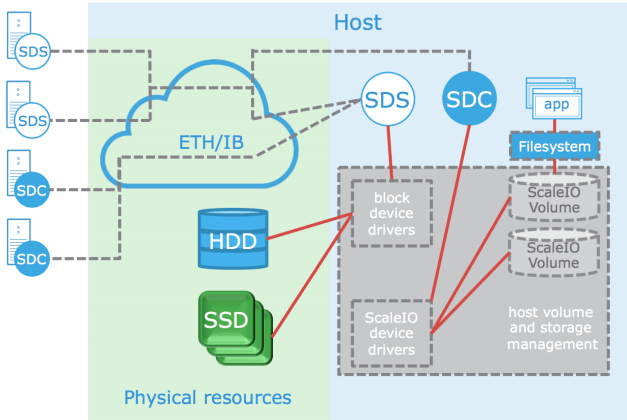Morning!
welcome to virtualcloudblog.com and thanks for checking it out. Today, I’ll write this post about DELL ScaleIO.
It’s a Software-defined storage (in advance SDS) which is a key driver of data center transformation. As a data center grade SDS, the enterprise features, availability, performance and flexibility of ScaleIO make it perfect for traditional array consolidation, private cloud/IaaS, and new emerging technologies like DevOps and container microservices.
ScaleIO.Next
ScaleIO introduces multiple space efficiency features including inline compression, space- efficient thin provisioning and flash-based snapshots. In addition, snapshots get an additional boost in ScaleIO.Next by enabling the creation of more snapshot copies, automating snap management and adding unrestricted refresh / restore capabilities.
This release enables even tighter integration with VMware environments with full vVols support, reducing overhead on the hypervisor, allowing administrators to consume data services at the VM granularity and offloading data services to ScaleIO.
ScaleIO is designed to support enterprises of any size and enable them to deliver massive scale, performance, elasticity and operational efficiency by using software automation.
- Consistently high performance – up to 10Ms IOPS.
- Independently increase capacity or performance
- Scale anywhere from 3 – 1000+ nodes.
- High I/O parallelism with low latency.
- Key features like snapshots, inline compression, thin provisioning, QoS.
- Enterprise data protection with rapid healing for fast recovery & higher availability
It converts direct-attached storage into shared block storage. ScaleIO is sold as software-only or preinstalled on commodity hardware.
How it works
It combines HDDs, SSDs, and PCIe flash cards to create a virtual pool of block storage with varying performance tiers. It features on-demand performance and storage scalability, as well as enterprise-grade data protection, multi-tenant capabilities, and add-on enterprise features such as QoS, thin provisioning and snapshots. ScaleIO operates on multiple hardware platforms and supports physical and/or virtual application servers.
ScaleIO works by installing software components on application hosts. Application hosts contribute internal disks and any other direct attached storage resources to the ScaleIO cluster by installing the SDS software. Hosts can be presented volumes from the ScaleIO cluster by leveraging the SDC software. These components can run alongside other applications on any server (physical, virtual, or cloud) using any type of storage media
The ScaleIO architecture is built on two components: a data client and a data server. The ScaleIO Data Client (SDC) is a lightweight device driver situated in each host whose application or file system require and he ScaleIO Data Server (SDS) is situated in each host and contributes local storage to the central ScaleIO virtual SAN.
Apart of that, an important component is also needed. Metadata Manager (MDM) A repository of storage metadata that manages the ScaleIO system and contains data required for system operation. MDMmanages metadata such as device mappings, volume information, snapshots, device allocations, used and remainingcapacity, errors and failures. The MDM also monitors the state of the storage system and is responsible for initiating systemrebuilds and rebalances. MDM interacts asychronously with SDC and SDS using a separate data path and will not impact their performance.


